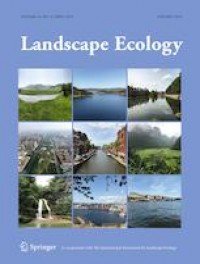Landscape Ecology Q1 Unclaimed
Landscape Ecology is the flagship journal of a well-established and rapidly developing interdisciplinary science that focuses explicitly on the ecological understanding of spatial heterogeneity. Landscape Ecology draws together expertise from both biophysical and socioeconomic sciences to explore basic and applied research questions concerning the ecology, conservation, management, design/planning, and sustainability of landscapes as coupled human-environment systems. Landscape ecology studies are characterized by spatially explicit methods in which spatial attributes and arrangements of landscape elements are directly analyzed and related to ecological processes. All manuscripts must show a keen awareness of the current literature and an immediate relevance to at least one of the following key topics: (1) Flows and redistributions of organisms, materials, and energy in landscape mosaics; (2) Landscape connectivity and fragmentation; (3) Ecosystem services in dynamic landscapes (especially, tradeoffs and synergies); (4) Landscape history and legacy effects; (5) Landscape and climate change interactions (particularly, mitigation and adaptation); (6) Landscape sustainability and resilience (e.g., relationships between ecosystem services and human well-being in changing landscapes); (7) Mechanisms and ecological impacts of land use change; (8) Scaling relations and hierarchical linkages of patterns and processes across landscapes; (9) Innovative methods in landscape analysis and modeling; and (10) Accuracy assessment and uncertainty analysis of landscape studies.A valuable resource for both researchers and practitioners in ecology, conservation, ecosystem management, and landscape planning and design, Landscape Ecology is currently one of the leading journals across these fields.
Editor-in-Chief: Jianguo (Jingle) Wu, Arizona State UniversityJournal of the International Association for Landscape Ecology (US and World)Covers relationships among landscape pattern, ecological processes and scaleExplores the nature and ecological consequences of land use and land cover changeReviews the effects of landscape heterogeneity on population dynamics, ecosystem processes, and ecosystem servicesExamines landscape fragmentation on biodiversity and ecosystem functioning94% of authors who answered a survey reported that they would definitely publish or probably publish in the journal again It has an SJR impact factor of 1,329.
Landscape Ecology focuses its scope in these topics and keywords: landscape, dynamics, grassland, habitat, network, transitions, appalachian, areal, avian, biotic, ...
Type: Journal
Type of Copyright:
Languages: English
Open Access Policy: Open Choice
Type of publications:
Publication frecuency: -


3190 €
Inmediate OANPD
Embargoed OA0 €
Non OAMetrics
1,329
SJR Impact factor158
H Index215
Total Docs (Last Year)657
Total Docs (3 years)17173
Total Refs3202
Total Cites (3 years)644
Citable Docs (3 years)3.76
Cites/Doc (2 years)79.87
Ref/DocOther journals with similar parameters
Nature Sustainability Q1
Fungal Diversity Q1
Genome Biology Q1
Human Reproduction Update Q1
Annual Review of Ecology, Evolution, and Systematics Q1
Compare this journals
Aims and Scope
Best articles by citations
Distribution of the Cinnabar moth Tyria jacobaeae L. at landscape scale: use of linear landscape structures in egg laying on larval hostplant exposures
View moreThe influence of sampling scheme and interpolation method on the power to detect spatial effects of forest birds in Ontario (Canada)
View moreDivergent effects of tropical forest fragmentation and conversion on leaf litter decomposition
View moreFire regimes and forest resilience: alternative vegetation states in the West African tropics
View morePhysical influences of landscape on a large-extent ecological disturbance: the northeastern North American ice storm of 1998
View moreThe development of forage production and utilization gradients around livestock watering points
View moreMaintenance of flying squirrel habitat and timber harvest: a site-specific spatial model in forest planning calculations
View moreBook review: Review of Ecoregion-Based Design for Sustainability
View moreLand use and forest cover on private parcels in the Upper Midwest USA, 1970 to 1990
View moreSpatial sensitivity of species habitat patterns to scenarios of land use change (Switzerland)
View moreLandscape-level movements of North American elk (Cervus elaphus): effects of habitat patch structure and topography
View moreScales of movement by elk (Cervus elaphus) in response to heterogeneity in forage resources and predation risk
View moreProjecting land use transitions at forest fringes in the Philippines at two spatial scales
View moreMapping alpine vegetation using vegetation observations and topographic attributes
View moreHistorical range of variability in eastern Cascades forests, Washington, USA
View moreSimulating the effects of climate change on population connectivity of American marten (Martes americana) in the northern Rocky Mountains, USA
View moreSpatial and non-spatial factors: When do they affect landscape indicators of watershed loading?
View moreThe land use-climate change-energy nexus
View moreEdge avoidance and movement of the butterfly Parnassius smintheus in matrix and non-matrix habitat
View more
Comments